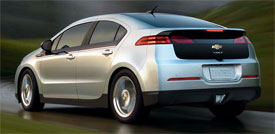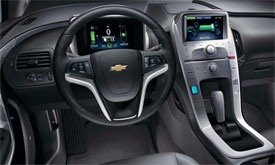2011 Chevrolet Volt
It was January of 2007 when General Motors first revealed its concept of an electric car with an onboard gasoline generator. It would be called Chevrolet Volt. Since then, we’ve been teased with numerous updates, and even had short drives in Volt prototypes. Well, now the time has come for the production Volt to greet its first real owners. And time for us to see if the Volt is really as electrifying as it’s hype.
General Motors has a lot riding on the 2011 Chevrolet Volt. This five-door compact’s revolutionary plug-in system is the cornerstone of GM’s green car efforts for the next decade. But, there are questions about how to classify the Volt. Is it an all-electric car as GM insists? Or, is it a very advanced plug-in gasoline-electric hybrid, with more in common with the Toyota Prius than the Nissan LEAF?
The best answer is, it’s both, depending on how it is driven. The Volt’s primary power source is always electric, with a 16 Kilowatt lithium-ion battery tied to a 149-horsepower electric drive motor. It provides a commute-friendly 35 to 45 mile electric-only range. But, when the battery is discharged, a 1.4-liter gasoline engine automatically starts, and turns a smaller motor/generator that provides juice for up to 310 miles, or until you run its 9.3 gallon gas tank dry.
 The controversy comes when you drive the Volt at speeds 70 miles an hour and above with the batteries depleted. Under this condition, the gasoline engine is mechanically linked to the drive wheels through the motor/generator. GM says this somewhat Prius-like feature boosts efficiency by 10 to 15%.
The controversy comes when you drive the Volt at speeds 70 miles an hour and above with the batteries depleted. Under this condition, the gasoline engine is mechanically linked to the drive wheels through the motor/generator. GM says this somewhat Prius-like feature boosts efficiency by 10 to 15%.
While GM kept this tidbit a secret waiting for patents to be approved, it does tarnish their all-electric claims. Still, we don’t think it matters. New car hype is just that. And we think owners will consider the Volt, first and foremost, an electric car, but one without pure-EV range limitations.
You can buy this vehicle and use it as a super-efficient, around town or commuter car, virtually never using any gasoline at all, or take it on a long family trip and know that you’ve got plenty of range to get to wherever your lunch stop or the next gasoline station might be.
So, how far does the Volt go on a gallon of premium gas? Well, again, it depends on how you drive it. If your commute is 15 to 20 miles, your MPG number will approach infinity. If you don’t recharge nightly, take long trips, or drive at high speeds, it’s more like 35-45 miles per gallon. But, then, you’re not the Volt’s target buyer. GM hopes the official government MPG-equivalent number will approach triple digits. We did see over 100 miles per gallon in two days of routine driving.
It takes about 10 to 12 hours to fully recharge the Volt using a 120-volt household outlet, about four hours at 240-volts. There’s even a smartphone apps to help to monitor charging and other Volt functions. Regenerative braking also helps replenish the battery. As to performance, Volt jolts from 0 to 60 in nine seconds. But it felt faster with strong throttle response. Top speed is about 100 miles per hour.
In all-electric mode, the Volt is smooth and quiet. Equally smooth is the transition from battery to gasoline power generation. Gas power sounds are muted until you bury the pedal. Then it sounds like most other four-cylinder engines under stress. There is also a Mountain Mode for sustained speed electric driving in hilly terrains.
Sharing a chassis with the Chevrolet Cruze, the independent front McPherson suspension and compound crank twist axle rear deliver a well-grounded drive experience. The ride is very solid. The Volt has a low center of gravity, so even going around tight corners, the car leans little. The steering is nicely dialed-in, and brakes are firm and linear. Most enthusiasts will be pleasantly surprised.
Although the production Volt has evolved since its concept days, most styling cues remain. A spit Chevy grille, tapered front corners, tight door seals, working front and rear spoilers, and low rolling resistance tires, that aid fuel economy, plus keep road noise low.
 The Volt’s cockpit echoes the same clean look as the exterior. The upwardly swept dash houses an uncluttered instrument panel with unique readouts to help drivers maintain efficiency. The center stack has a large touchscreen display, soft touch switchgear, and a larger grabbable shifter.
The Volt’s cockpit echoes the same clean look as the exterior. The upwardly swept dash houses an uncluttered instrument panel with unique readouts to help drivers maintain efficiency. The center stack has a large touchscreen display, soft touch switchgear, and a larger grabbable shifter.
Standard is a Bose stereo, automatic climate control, remote ignition and Bluetooth. Hard drive navigation and rear-view camera are options. The Volt offers comfortable seating up front, with lots of leg and headroom for a six-footer, and optional heat. Rear passenger room is ample also, but remember, it’s only for two. Under the rear hatch, cargo volume is limited to 10.6 cubic feet, but the seatbacks do fold for more.
Base pricing for the Volt is $41,000 before federal and state tax breaks. Most buyers will pay no more than $33,500. Even more attractive is the Volt’s lease option, at $2,500 down and $350 a month.
With its unique extended range approach to green motoring, the 2011 Chevrolet Volt is impressive. No matter if you call it an electric car or a hybrid, it combines the best gas-saving, plug-in technologies yet available for an uncompromising driving experience. We think the Volt was well worth the wait, with or without the hype.
Specifications
- Engine: 16 Kilowatt Lithium-ion Battery1.4-Liter Gasoline Engine
- Horsepower: 149
- 0-60 MPH: 9.0 Seconds
2024 Toyota Land Cruiser
Toyota’s Go Anywhere Globetrotter Returns To U.S.
Every once in a while, we all need a reset. A time to get back to basics and prioritize the things that really matter. Well, for the Toyota Land Cruiser that time is now. So, let’s find out if that means bigger and better things for Toyota’s iconic off-roader.
The Toyota Land Cruiser’s status among the global off-road community is legendary, and it’s hard to imagine there’s any corner of the earth where a Land Cruiser hasn’t kicked up a little dust or mud. Well, 2024 sees the return of the Land Cruiser to the U.S. market after a 3-year hiatus, getting a major reset for the journey.
The reset comes mostly by no longer being based on the large three-row “300-series” chassis, but a new version of the smaller “200-series,” now known as the J250. As with the latest Tacoma, it uses the Tundra pickup’s full-size steel frame.
While the main Land Cruiser model, which goes by simply Land Cruiser, is packed full of luxury and convenience features, there is also a stripped-down model known as the 1958, honoring the first year the Land Cruiser made landfall here in North America. And it is that 1958 we have here, and we were glad to see it, as it also celebrates the original’s back-to-basics approach as a blank canvas for you to personalize as you tackle more and more adventures.
Not that it’s fully stripped down, as 8-inch touchscreen infotainment, a 7-inch full-color multi-information display, and automatic climate control are still standard. Plus, some seriously durable materials, and great heated cloth front seats that throw off some get serious 1990s Tacoma vibes.
But outside, there’s a definite lack of flashy trim and basic looking 18-inch wheels with Yokohama Geolander all-season tires; plus, big chunky bumpers and tilt-up back glass, which is a rarity that we appreciate. Though there is a little too much plastic in places that are sure to see some abuse if you do any significant off-roading.
It even feels a little rough around the edges, but for us it just adds to the rugged old-school utility vibe in a good way.
We did just that, both here in the Mid-Atlantic as well as in the California desert; and while there are some tech-forward driving aids, the actual hardware is in most cases plenty to get things done. That includes standard full-time dual-range four-wheel-drive, locking center and rear diffs, and 8.7-inches of ground clearance. A front stabilizer bar disconnect is also available to allow for increased articulation.
Who needs a V6 or even a V8 when you’ve got Toyota’s i-FORCE MAX setup at your disposal with 326 horsepower and 465 lb-ft of torque coming from a 2.4-liter turbo-four with an electric motor sandwiched between the engine and its eight-speed automatic transmission. Low speed torque delivery is impressive. It even feels a little rough around the edges, which may be a turn off to some, but for us it just adds to the rugged old-school utility vibe in a good way.
And it certainly feels quicker than an off roader needs to be, with an instant torque dump as soon as we eased on the throttle at our Mason Dixon test track; helping us get to 60 in 8.1 seconds and through the quarter-mile in 16.3 seconds at 86 mph. Considering the Land Cruiser’s terrain conquering mission, it behaved quite well in our handling course; it was plenty responsive to inputs, with less body roll than we expected and plenty of grip from the tires. The steering was light and quick but as expected didn’t provide much feel. Other than significant nosedive, braking performance was exceptional. Only 107-feet to panic stop us from 60 mph.
With the shift to the smaller size, there’s no more third row available, and cargo capacity now comes in at 46.2 cubic-feet with a max of a still healthy 82.1. Now, the best part of the Land Cruiser’s return is the entry price of $57,445. That’s about 30-grand less than what the last Land Cruiser went for back in 2021.
Whether it’s over the top fashion trends, mullets, or zombies; just when you think they’re dead, they come roaring back to life. Of course, we’re much happier to see the resurrection of this 2024 Toyota Land Cruiser than any of those things. Toyota is one brand that still recognizes the value of full-framed rugged rigs and has also acknowledged that sometimes less really is more. The Godfather of Toyota off-roading is back and better than ever.







